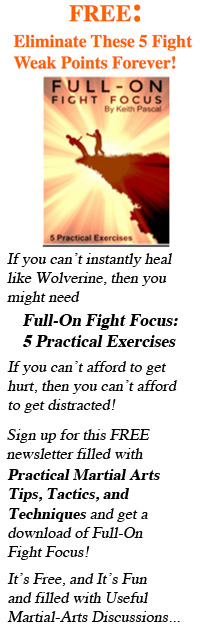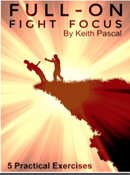JKD vs MMA
Martial Arts Definitions
This really isn’t a blog post about a Jeet Kune Do fighter taking on a MMA fighter; rather, it’s about the confusion of ‘mixing martial arts” with “Mixed Martial Arts” (MMA).
Mixed Martial Arts is a sport, a competition with rules. It just so happens that the sport — and it is a sport, no offense intended — is made up a variety of martial arts styles, this the notion of mixing.
So, people assume that JKD is similarly a mixing of a variety of martial arts styles.
Jeet Kune Do Is NOT Just Mix-and-Match
Most people think that bits from each style make up JKD … I have come to believe that this isn’t necessarily so. I think it’s more that the principles aren’t limited to any one style; they can be found within almost any style and don’t even have to be associated with a certain system … but each single style does have limitations. The styles themselves won’t be faithful to all the principles of JKD.
So, if you were faithful to Bruce Lee, you’d have to be brutally honest and eliminate some of the stuff from any classical style, including wing chun and western boxing, two of the styles that Bruce Lee borrowed from for his Way.
Implementing Bruce Lee’s Ideas
You eliminate the inefficient. You dump the moves that make you susceptible to feints and fakes.
Then you fill in the gaps, with pieces from other styles. The whole time, you stay faithful to the principles of JKD.
Note: Did you know that The Punch eCourse is one of the only places that you can really learn all of Bruce Lee’s Punch-Check Combinations. In fact, I stay faithful to Bruce Lee’s teachings throughout all five volumes … especially the volume on punch strategy.
To me, this is different from MMA. Neither is it simply mixing and matching any move from any style, just to have an arsenal of techniques. JKD was meant to be dynamic … you have to continuously examine and reexamine what you do … always striving for improvement … for ways to approximate Bruce Lee’s principles more faithfully and precisely.
This is different than just mixing and matching.
Tags: bruce lee, jeet kune do, jkd, jkd vs mma, martial arts tactics, mixed martial arts, mma, mma vs jkd, strategy, tactics, wing chun



Depending on your understanding of JKD (the Inosanto version which promotes self learning of several martial arts and the subsequent ignoring the irrelevant of those arts to produce personal style or the other version widely taught that believes that the techniques Bruce Lee taught were the only techniques that should be taught and are enough for JKD) This question is quite simple.
Considering JKD fathered MMA so that really MMA is a ruled sport version of JKD.
JKD is purely self defence while MMA is for sport.
JKD strongly encourages groin and throat attacks as well as weapons training and an altered stance to protect your center line which is not advised in MMA competitions as it can leave you open for takedowns.
Principle wise, they are similar but there is a larger philosophy and understanding to JKD.
But most MMA fighters started as JKD practitioners and such many of Lee’s conditioning methods are widely used. I mean its hard to spar unless there is a limit on your attacks to prevent students killing each other, hence MMA was born (AKA sport JKD).
To be honest JKD isn’t revolutionary for its belief in learning and combining many styles (which many martial artists did in the past) but rather its philosophy of encouraging student to study other martial arts to create their own personal style.
KUNG HEI FAT CHOI – from Hong Kong
sorry i meant to write “irrelevant”. as Lee described it “The floweriness in classical martial arts” although the “floweriness” is used in Escrima as a feint. Really depends on your understanding again.
You should tell people to buy the “Tao of Jeet Kune Do” if they are having troubling understanding what JKD really is
Zaad,
Well, for “my” understanding … all three missed the boat (and I mean no disrespect to any of them):
1. JKD Concepts incorporated too much Filipino. They had a great idea, but they kept some of the inefficient parts of the system, like going off centerline (look at the bad practices found within Hu Baud, for example). I like Dan Inosanto, a lot. He has said great things about one of my books. I just think he didn’t stay faithful to the truly important concepts of JKD.
2. The JFJKD crew, while doing some great stuff (like the Concepts group), got stuck at a more grade-school level of martial arts. They stopped progressing. Bruce Lee would have called them children … who only regurgitate what was taught, and never followed the true intent of the system to progress. (Yes, I know that they claim that you should progress on your own after getting the pure “Foundation.” It just doesn’t work out that way.)
3. MMA stemmed from JKD? Really? I can’t believe that, at all. I see so much telegraphing, strong blocks, high kicks, etc., that it can’t even be related, right? It’s loads of fun to watch … but it isn’t even close to real self-defense. As you say, lots of rules.
I like what you wrote, Zaad … I think you are on the right track. And you may have inspired me to write an ebook on the weaknesses of current JKD … I could get specific.
Thanks, again,
Keith
Zaad,
Permit me to give you an example of how online can supplement offline learning:
In The Punch eCourse, (http://kerwinbenson.com/martial_arts_books/punch-ecourse/) one of the first tasks in Volume One: Fundamentals is for you to go learn a new punch. It doesn’t matter from whom, and it doesn’t matter what kind of punch.
The point is to go offline and learn an unfamiliar punch … then you bring it back to the lesson, and the ebook teaches you how to tweak it, to improve it.
If you are already an accomplished martial artist, then maybe only one or two of the changes will be new to you, but if you are an intermediate or beginning practitioner, then all of the advice will seem like gold.
Do you see how we blend the offline world with the online, together? And I am here to answer questions, examine videos, etc.
But my first piece of advice is to use my materials as supplements to what you are already doing or learning.
For years, I advertised “Getting the Edge in Martial Arts.” I don’t teach a complete style online … I write information that can help you improve.
I hope this helps explain “this nut case’s point of view.” 😉
Purely from a Sport Sciene and Literature point of view, the Tao of JKD book contains both the philosophies of JKD as well as a study of the development of Lee’s personal style there by creating a guide of how others should intend to create their personal style and what skills they should focus on but not necessarily limit themselves to. Interpretations are a large factor of this book.
yeah i heard about Inasanto using too much of filipino arts in his teaching. i assumed by naming themselves “Concepts” that they would in fact teach they philosophies and concepts of JKD.
I totally agree with your second point. it is just regurgitating whats been taught without passing on the full understanding and history of what they are teaching (i see this quite often in martial arts teachers e.g. the conditioning methods taught by my muay thai instructor).
Yeah MMA now is largely telegraphed with no real development of personal style. everyone uses the standard combination of muay thai for stand up and BJJ for groundwork, this is so common that many places teach MMA as a style. Current MMA is a more mutated form of JKD that adopts many forms rather than having no form. Current MMA; straight up – it is a sport. too much emphasise floor rolling (bad for self defence) and has no weapons work. but it is the closest many will get to JKD in a class room and the sport has boosted the popularity of JKD after dana white called bruce lee the father of MMA.
PS (I apologise for not writing properly and i only really do muay thai cos it is great cardio but is unfortunately not really technical apart from cliche work.)
Zaad, your writing is fine 🙂
As to the Tao of Jeet Kune Do, the original big grayish book with the Bruce Lee in shadows on the cover … almost nobody knows that it was not composed of his conclusions. They were just notes to himself.
Some of the stuff in there were questions in the form of notes, that he wanted to explore later. And then he later disproved some of it.
Other pieces are pure gold.
If you want, what I think are the real gems of Bruce Lee’s thoughts and conclusions, then I like the series edited by John Little. Specifically, I love Jeet Kune Do #3. It’s a goldmine of Bruce-Lee thought.
Keith
PS #4, The Art of Expressing the Human Body has all of Bruce Lee’s physical workouts. I love reading about the plans … more than doing them 😉
By the way, Jeet Kune Do, #3 and #4 are my favorites. The others are fine, but these two have my catch phrase in them … “the hidden gems of martial arts.”
Just a little FYI … and a humble opinion,
Keith
I loved The Art of Expressing the Human Body, it had the specific exercises and routines, as well as the layout to creating and varying new conditioning circuits. 🙂 He built it in a ladder sequence to always improve and never go back. I base some of my workouts on that book. 😀
P.S. Great article, Kip!
Aw shucks 🙂
I find the rope or chain on the dowels super valuable. Bruce used those routines for his travel workouts. The equipment, as mentioned in the book, is very portable.